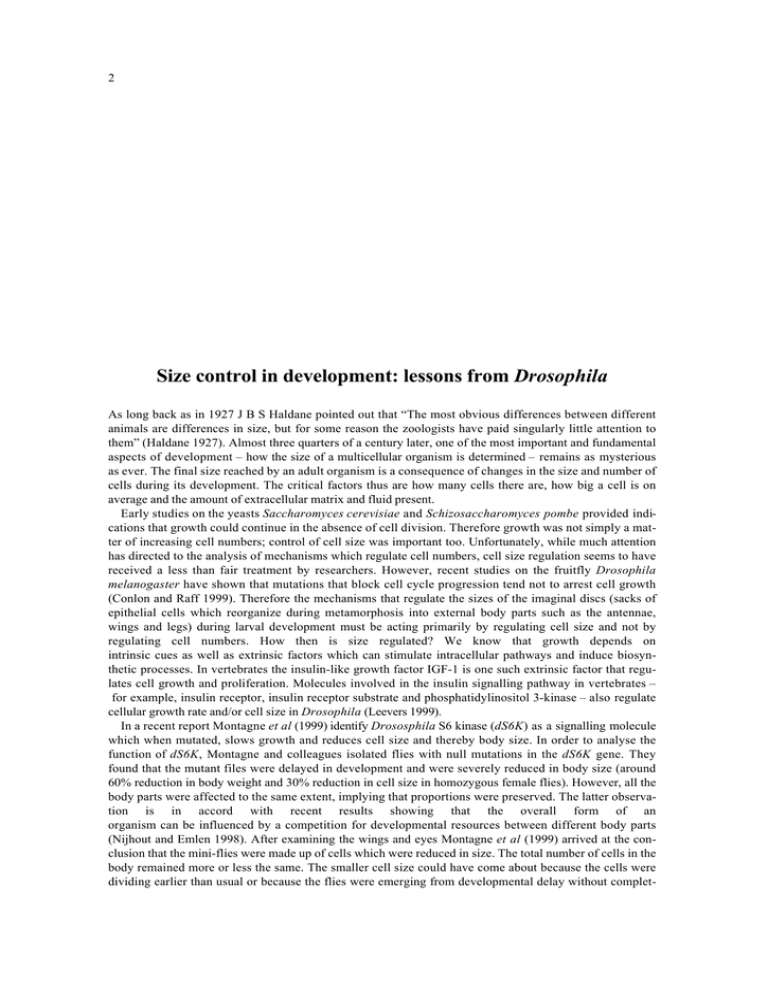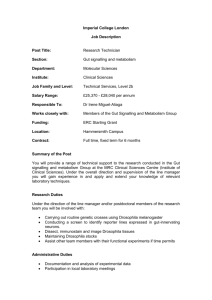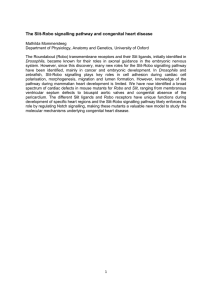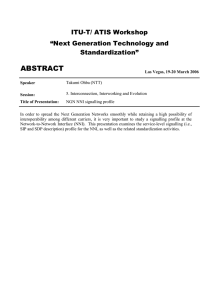Drosophila
advertisement

2 Size control in development: lessons from Drosophila As long back as in 1927 J B S Haldane pointed out that “The most obvious differences between different animals are differences in size, but for some reason the zoologists have paid singularly little attention to them” (Haldane 1927). Almost three quarters of a century later, one of the most important and fundamental aspects of development – how the size of a multicellular organism is determined – remains as mysterious as ever. The final size reached by an adult organism is a consequence of changes in the size and number of cells during its development. The critical factors thus are how many cells there are, how big a cell is on average and the amount of extracellular matrix and fluid present. Early studies on the yeasts Saccharomyces cerevisiae and Schizosaccharomyces pombe provided indications that growth could continue in the absence of cell division. Therefore growth was not simply a matter of increasing cell numbers; control of cell size was important too. Unfortunately, while much attention has directed to the analysis of mechanisms which regulate cell numbers, cell size regulation seems to have received a less than fair treatment by researchers. However, recent studies on the fruitfly Drosophila melanogaster have shown that mutations that block cell cycle progression tend not to arrest cell growth (Conlon and Raff 1999). Therefore the mechanisms that regulate the sizes of the imaginal discs (sacks of epithelial cells which reorganize during metamorphosis into external body parts such as the antennae, wings and legs) during larval development must be acting primarily by regulating cell size and not by regulating cell numbers. How then is size regulated? We know that growth depends on intrinsic cues as well as extrinsic factors which can stimulate intracellular pathways and induce biosynthetic processes. In vertebrates the insulin-like growth factor IGF-1 is one such extrinsic factor that regulates cell growth and proliferation. Molecules involved in the insulin signalling pathway in vertebrates – for example, insulin receptor, insulin receptor substrate and phosphatidylinositol 3-kinase – also regulate cellular growth rate and/or cell size in Drosophila (Leevers 1999). In a recent report Montagne et al (1999) identify Drososphila S6 kinase (dS6K) as a signalling molecule which when mutated, slows growth and reduces cell size and thereby body size. In order to analyse the function of dS6K, Montagne and colleagues isolated flies with null mutations in the dS6K gene. They found that the mutant files were delayed in development and were severely reduced in body size (around 60% reduction in body weight and 30% reduction in cell size in homozygous female flies). However, all the body parts were affected to the same extent, implying that proportions were preserved. The latter observation is in accord with recent results showing that the overall form of an organism can be influenced by a competition for developmental resources between different body parts (Nijhout and Emlen 1998). After examining the wings and eyes Montagne et al (1999) arrived at the conclusion that the mini-flies were made up of cells which were reduced in size. The total number of cells in the body remained more or less the same. The smaller cell size could have come about because the cells were dividing earlier than usual or because the flies were emerging from developmental delay without complet- Clipboard 3 ing the last round of cell growth. To examine these possibilities the authors analysed the imaginal discs of the mutants. It turned out that the discs were smaller than usual (as expected) and that the cells in them, which were also small, grew at a slower rate than normal. Thus, in the absence of dS6K, a miniature but perfectly formed fly containing the normal number of cells is formed. In vertebrates the S6 kinases regulate the synthesis of a family of proteins, primarily components of the translational apparatus, in response to the insulin signalling pathway. In S6K1 deficient mice, the derived liver and embryonic cells show unimpaired phosphorylation of S6 thanks to compensation by S6K2 but the gene disruption results in a small mouse. The involvement of protein synthesis in growth control in Drosophila is not surprising, a class of mutants called Minutes are known to delay development and slow growth rate and division. Also, recently a screen to identify genes required for larval growth identified a translation initiation factor, EiF4A. Minute genes encode components of the ribosomal translational machinery. However, these mutations do not alter cell size, showing that cell growth and cell division are normally coupled in order to maintain an appropriate cell size. This suggests that in the dS6K mutant, growth per se is not severely impaired; the number of cell divisions required to maintain normal cell numbers still occurs. Thus, dS6K identifies a branch of the insulin signalling pathway likely to be involved in growth control by affecting growth at the cellular level and thereby modulating organ and body size. The challenge now is to find out how this signalling network is controlled in response to environmental and developmental cues. We need to understand what switches it on, and most importantly what switches it off, as this may be the way in which the final body size is determined. References Conlon I and Raff M 1999 Size control in animal development; Cell 96 235–244 Haldane J B S 1927 On being the right size; in Possible worlds and other essays (London: Chatto and Windus) Leevers S J 1999 All creatures great and small; Science 285 2082–2083 Montagne J, Stewart M J, Stocker H, Hafen E, Kozma S C and Thomas G 1999 Drosophila S6 Kinase: A regulator of cell size; Science 285 2126–2129 Nijhout H F and Emlen D J 1998 Competition among body parts in the development and evolution of insect morphology; Proc. Natl. Acad. Sci. USA. 95 3685–3689 TRUPTI S KAWLI Department of Molecular Reproduction, Development and Genetics, Indian Institute of Science, Bangalore 560 012, India J. Biosci. | vol. 25 | No. 1 | March 2000








